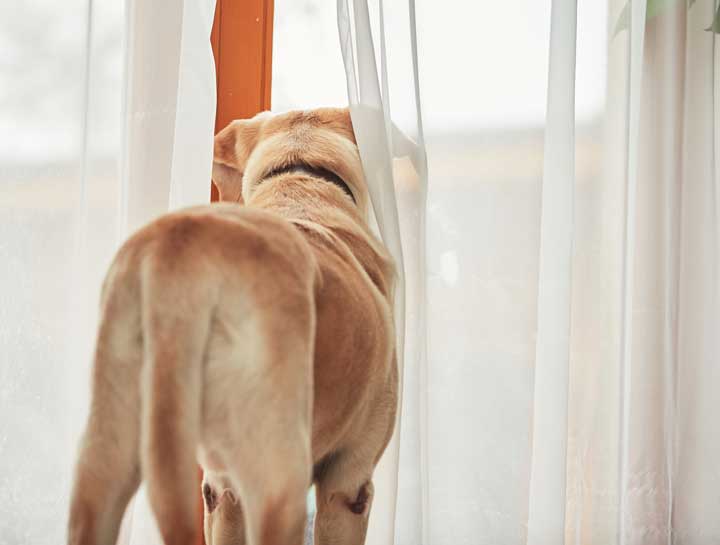Separation Anxiety in Latchkey Pets

As much as you enjoy your pet’s company, you simply cannot take them everywhere. While most pets adjust to being home alone, others develop separation anxiety, resulting in severe stress for the affected pet. Pets suffering from separation anxiety also are frequently destructive when their owner is absent, causing costly damage to your home. Our team at Medina Veterinary Clinic would like to help you and your pet by offering information about this concerning issue.
How do I know if my pet is affected by separation anxiety?
Boredom in pets can mimic separation anxiety. If you are unsure if your pet is bored or suffering from separation anxiety, videotaping them while you are gone should elucidate the issue. Signs indicating separation anxiety include:
- Clinginess — Pets will remain close to their owners, following them from room to room, and will rarely spend time alone. They are also usually high maintenance pets who require a lot of time and attention.
- Anticipation — Pets will start to get anxious when their owners are preparing to leave the house. They may vocalize or seek attention from their owner, and attempt to maintain contact.
- Panic — Once their owner leaves, pets will vocalize, eliminate inappropriately, and be uninterested in food. They also may tremble uncontrollably.
- Destruction — Pets will frequently become destructive when their owner is gone.
- Excitement — When their owner returns, pets will exhibit excessive excitement.
Bored pets are typically not as concerned when their owner leaves, and usually begin the destructive behavior when their owner has been gone for longer than 30 minutes.
How can I immediately manage my pet’s separation anxiety?
Retraining your pet with separation anxiety requires time, and unfortunately, there are no quick fixes. Approaches you can take include:
- Having a friend or pet sitter stay with your pet
- Taking your pet to a pet daycare facility
- Taking your pet with you to work
- Taking time off work to retrain your pet
How do I retrain my pet who is affected by separation anxiety?
Separation anxiety can be difficult to treat, and you will need to be patient. Steps to take to retrain your pet include:
- Alone time — You will need to teach your pet that they can enjoy being alone. Establish a safe area for your pet where they can rest, and provide familiar toys, and clothing you have recently worn. Tell them to stay, and walk several steps away, ensuring they remain in place. Give them a treat for not following you. You can gradually increase the distance, and eventually leave the room. Once they allow you to leave the room, you can gradually increase the time you spend in another room. A food-puzzle toy can help distract your pet during this step.
- Pre-departure cues — Everybody performs certain tasks right before they leave the house. Maybe you put on your shoes and pick up your keys, or grab your bag and turn off the lights. No matter your departure cues, go through these steps, but don’t leave the house. Practice this several times a day until your pet no longer exhibits anxiety.
- Departure — Once your pet remains calm during your pre-departure cues, open the door, but don’t leave the house. If your pet doesn’t get upset, you can walk out the door, but leave the door open. When they are comfortable with this step, close the door, but return after a minute or two. You can then gradually increase the time you are gone.
When my pet seems ready, how should I handle leaving the house?
Give your pet a vigorous workout, and take them to their safe area to relax. Offer them a meal or treat inside a food puzzle toy, and quietly make your exit while they are distracted. Your initial forays should be for 30 minutes or less. You can gradually increase your trips when your pet acclimates to the situation. When you return home, don’t acknowledge your pet until they are calm.
What should I do if my pet makes a mess while I’m away?
If your pet is destructive or soils the house while you are away, any response can further exacerbate the situation. Avoid excited greetings, and definitely do not punish your pet. They are not acting spitefully—they are truly extremely upset and stressed.
Can drug therapy help my pet with separation anxiety?

Drug therapy can be beneficial for pets affected by separation anxiety, especially in the early retraining stages. Sedatives alone do not decrease your pet’s anxiety levels, but can help prevent destructive behavior when you have to leave them alone for short periods. Anti-anxiety medications can also help reduce your pet’s stress, but drugs alone cannot “fix” your pet. They will still need to be retrained to accept that they have to spend time away from you. Our veterinary professionals at Medina Veterinary Clinic will be able to determine if medications are appropriate for your pet.
Separation anxiety can be difficult to treat, but retraining your pet to learn to accept your absence is the best method to relieve their distress. If your pet is affected by separation anxiety, and you would like help managing their condition, do not hesitate to contact our team at Medina Veterinary Clinic, to schedule an appointment.
By Medina Veterinary Clinic | September 9th, 2021
